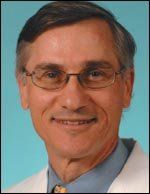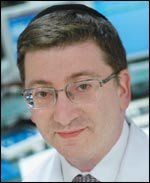Should radiation therapy plus hormone therapy be the new standard of care for locally advanced prostate cancer?
New studies show dramatic results in overall and progression-free survival, but not all patients will benefit from aggressive treatment.
ABSTRACT: New studies show dramatic results in overall and progression-free survival, but not all patients will benefit from aggressive treatment.
Androgen deprivation therapy has become the primary treatment for men with locally advanced prostate cancer in the last two decades, but emerging data suggest that ADT alone is not as effective as ADT plus external-beam radiation therapy. Most recently, international researchers claimed their data are strong enough to make continuous ADT plus EBRT the new standard of care.
PRO
Presented by DR. PADRAIG WARDE

© ASCO/Todd Buchanan 2010
Data from a large, randomized international trial (Intergroup T94-0110) demonstrated a 43% reduction in the risk of dying from prostate cancer for men who were given combination therapy vs ADT alone. The new data challenge the prevailing approach of using only hormone therapy for locally advanced prostate cancer, said lead investigator Padraig Warde, MB, MRCPI, deputy head of the radiation medicine program at the University of Toronto's Princess Margaret Hospital. "It wasn't until now that we have had the proof. Now, we have definitive proof," Dr. Warde told Oncology News International.
Also speaking in favor of ADT plus EBRT is Nicolas Mottet, MD, PhD, who led a study that found combination therapy was superior to ADT alone when patients were tracked for a median follow-up of five years. Dr. Mottet is a urologist and medical oncologist at the Clinique Mutualiste in St. Etienne, France.
But ADT plus EBRT is not without its drawbacks, and these include the cost of combination treatment, the potential morbidity associated with such aggressive therapy, and the treatment options for patients once combination therapy is completed. Oncology News International spoke with several physicians about the issues that prostate cancer specialists need to consider when deciding on the best course of action.
Boosting overall survival
Men who received the combination therapy lived longer and were less likely to die of their prostate cancer than those who had only hormone therapy, according to the results of the study led by Dr. Warde (American Society of Clinical Oncology [ASCO] 2010 abstract CRA 4504).
He and his colleagues found a 74% seven-year overall survival (OS) rate among the 603 men in their patient population who underwent ADT plus EBRT. That was considered significantly superior to the 66% seven-year OS rate observed for the 602 subjects who received hormone therapy alone (hazard ratio = 0.77). When the researchers examined disease-specific survival (DSS) they again found dual therapy was superior with a seven-year rate of 90% compared with 79% in the hormone deprivation arm (HR = 0.57).
In this study, 320 deaths occurred in the total population of 1,205 patients (175 of them in the ADT-only arm and 145 among men receiving dual therapy). Notably, 89 deaths (26%) in the ADT-only group were attributed to prostate cancer compared with 51 deaths (10%) in the dual-therapy group. The researchers also found that those who received dual therapy lived six months longer on average than those who received ADT alone. Dr. Warde noted that there were no significant increases in long-term gastrointestinal toxicity between treatment groups.
Radiotherapy in this trial consisted of 45 Gy in 25 fractions to the pelvis over five weeks plus 20 to 24 Gy in 10 to 12 fractions to the prostate over 2 to 2.5 weeks. The regimen was based on a protocol that was designed in 1993 and activated in 1995. Due to the fact that more intensive radiation has become common in recent years, Dr. Warde said efficacy results might have favored dual therapy even more had the radiation protocol been designed according to current practices.
Dr. Warde noted that a large trial out of Scandinavia also found a significant improvement in disease-specific mortality with dual therapy vs ADT alone. A phase III trial involving 875 men with locally advanced prostate cancer demonstrated a 10-year disease-specific mortality rate of 23.9% for patients with ADT alone vs 11.9% for men receiving ADT plus radiation (Lancet 373:301-308, 2009).
"This is now an education issue," Dr. Warde said. "This combination therapy should be considered the standard of care, provided the patients are able to tolerate the treatment. Some patients are apprehensive about radiation, but once you explain what is happening, you can address that fear."
He said that in this trial there was no increase in serious morbidity with the use of radiation. The analysis of adverse events revealed that late severe toxicities were rare, with adverse events affecting the genitourinary system observed in only 2.3% of men in each trial arm. However, low-grade diarrhea and rectal bleeding were found to be more common for the arm that included the use of radiation.
Dramatic progression-free survival
In the multicenter, randomized trial conducted by Dr. Mottet's group, 263 men (mean age of 70) were enrolled. Ninety-three percent of the subjects had T3 disease. With a median follow-up of 67 months, the investigators found the five-year clinical progression-free survival (PFS) was 88.7% for the dual-therapy arm vs 62.3% for the ADT-only arm. In addition, the investigators found that the cumulative incidence of locoregional progression at five years was 9.7% for dual therapy compared with 29% for ADT only. The cumulative incidence of metastatic progression at five years was 3% in the dual-therapy group vs 10.8% in the ADT-only group (ASCO 2010 abstract 4505).

CON
Presented by DR. GERALD ANDRIOLE

CON
Presented by DR. MARK GARZOTTO

CON
Presented by DR. JAMES MOHLER
Dr. Mottet said he was surprised by the dramatic differences between the two arms of the study. "The surprise was the magnitude of the differences and their early occurrence. There is no place for ADT-only in patients with locally advanced disease and a life expectancy of more than five years."
However, he stressed that treatment decisions in this patient population should be guided more by patients' comorbidities than their age.
Promising option but not right for all
Gerald Andriole, MD, chief of urology at Washington University School of Medicine in St. Louis, concurred that hormonal therapy is not enough for locally advanced prostate cancer but he pointed out that cost is an issue. "For locally advanced prostate cancer, we need more than hormonal therapy. The magnitude of the survival is significant and the side effects from radiation should be low," he said. "So the risk-benefit ratio appears to strongly favor the combined therapy vs hormone therapy alone. Cost is something to think about. Contemporary radiation is rather expensive and it can cost $20,000 to $30,000 [per treatment]."
Mark Garzotto, MD, an associate professor of urology and radiation medicine at Oregon Health & Science University in Portland, pointed out that aggressive therapy may fail to eradicate the cancer or the patient may die prematurely of other causes.
"The data are impressive for improved survival and should be considered the new standard," Dr. Garzotto said. "However, not all men benefit from aggressive therapy. The improved rate of OS was a difference of 8%. So the chance of improved OS is 8% for a man choosing radiotherapy plus ADT over ADT alone. This is enough to make this the standard of care, but not enough to make it the right choice for all men. Certainly men with multiple comorbidities or a short life expectancy are groups that I would look at closely."
James Mohler, MD, chair of the NCCN prostate cancer guideline panel and chair of urology at Roswell Park Cancer Institute in Buffalo, New York, said that adding radiation therapy to ADT needs to be looked at on a case-by-case basis. ADT alone may still be the appropriate choice for men with life expectancies of less than five years, he said. Also, disease management for some patients may depend on shortening the length of time that they are on ADT. Continuous ADT, especially when used for prolonged periods, may lead to myocardial infarction and congestive heart failure in patients with cardiovascular disease. There are also issues with bone demineralization, metabolic syndrome, and impaired quality of life (hot flashes, decreased libido) with prolonged ADT, he said.
Dr. Mohler suggested that for patients who can tolerate-and desire-aggressive treatment for locally advanced prostate cancer, new evidence suggests that surgery may be underutilized and a better option than either ADT or ADT plus radiation therapy.
"ADT plus radiation and surgery are the preferable options vs ADT alone for men with locally advanced prostate cancer. Radiation should be added to ADT for these men when life expectancy exceeds 5 years. In addition, new evidence suggests that we have offered operation too rarely for men with locally advanced prostate cancer."
In fact, he said, "surgery may be a better option in younger men (age 60 and under) who seek aggressive therapy."

VANTAGE POINT

MICHAEL ZELEFSKY, MD Physician education key to new standard of care
Many oncologists have been under the impression that hormonal therapy alone could accomplish the same thing as combined modality therapy, said Dr. Zelefsky, a professor of radiation oncology and chief of brachytherapy services at Memorial Sloan-Kettering Cancer Center in New York. The Canadian and French studies refute that theory, so educating clinicians about these studies is paramount, he said.
Dr. Zelefsky added that in addition to improved survival outcomes, ADT plus radiation therapy will afford patients the opportunity to go off hormone therapy earlier in the course of their disease. "These studies address a point that, to date, has never been addressed," he explained. "Radiotherapy may allow patients to stay on hormonal therapy for a limited period of time. It may be two or three years of hormonal therapy, which would be an advantage over staying on hormonal therapy indefinitely. I would consider the use of hormonal therapy alone as an alternative and inferior option. Nevertheless, in selected patients with significant comorbidities, hormonal therapy alone may be a reasonable consideration."
Prolaris in Practice: Guiding ADT Benefits, Clinical Application, and Expert Insights From ACRO 2025
April 15th 2025Steven E. Finkelstein, MD, DABR, FACRO discuses how Prolaris distinguishes itself from other genomic biomarker platforms by providing uniquely actionable clinical information that quantifies the absolute benefit of androgen deprivation therapy when added to radiation therapy, offering clinicians a more precise tool for personalizing prostate cancer treatment strategies.